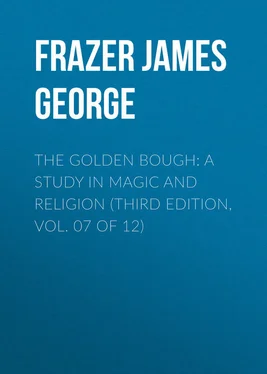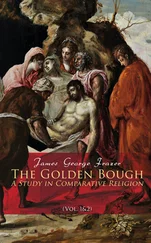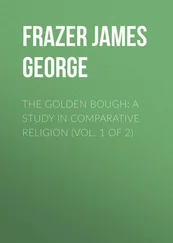James Frazer - The Golden Bough - A Study in Magic and Religion (Third Edition, Vol. 07 of 12)
Здесь есть возможность читать онлайн «James Frazer - The Golden Bough - A Study in Magic and Religion (Third Edition, Vol. 07 of 12)» — ознакомительный отрывок электронной книги совершенно бесплатно, а после прочтения отрывка купить полную версию. В некоторых случаях можно слушать аудио, скачать через торрент в формате fb2 и присутствует краткое содержание. Жанр: foreign_religion, foreign_antique, foreign_prose, на английском языке. Описание произведения, (предисловие) а так же отзывы посетителей доступны на портале библиотеки ЛибКат.
- Название:The Golden Bough: A Study in Magic and Religion (Third Edition, Vol. 07 of 12)
- Автор:
- Жанр:
- Год:неизвестен
- ISBN:нет данных
- Рейтинг книги:5 / 5. Голосов: 1
-
Избранное:Добавить в избранное
- Отзывы:
-
Ваша оценка:
- 100
- 1
- 2
- 3
- 4
- 5
The Golden Bough: A Study in Magic and Religion (Third Edition, Vol. 07 of 12): краткое содержание, описание и аннотация
Предлагаем к чтению аннотацию, описание, краткое содержание или предисловие (зависит от того, что написал сам автор книги «The Golden Bough: A Study in Magic and Religion (Third Edition, Vol. 07 of 12)»). Если вы не нашли необходимую информацию о книге — напишите в комментариях, мы постараемся отыскать её.
The Golden Bough: A Study in Magic and Religion (Third Edition, Vol. 07 of 12) — читать онлайн ознакомительный отрывок
Ниже представлен текст книги, разбитый по страницам. Система сохранения места последней прочитанной страницы, позволяет с удобством читать онлайн бесплатно книгу «The Golden Bough: A Study in Magic and Religion (Third Edition, Vol. 07 of 12)», без необходимости каждый раз заново искать на чём Вы остановились. Поставьте закладку, и сможете в любой момент перейти на страницу, на которой закончили чтение.
Интервал:
Закладка:
Date of the Eleusinian games uncertain.
If the Ancestral Contest at the Eleusinian games was, as I have conjectured, a contest between the reapers on the sacred barley-field, we should have to suppose that the games were celebrated at barley-harvest, which in the lowlands of Greece falls in May or even at the end of April. This theory is in harmony with the evidence of the scholiast on Pindar, who tells us that the Eleusinian games were celebrated after the corn-harvest. 272 272 Scholiast on Pindar, Olymp. ix. 150, p. 228, ed. Aug. Boeckh.
No other ancient authority, so far as I am aware, mentions at what time of the year these games were held. Modern authorities, arguing from certain slight and to some extent conjectural data, have variously assigned them to Metageitnion (August) and to Boedromion (September), and those who assign them to Boedromion (September) are divided in opinion as to whether they preceded or followed the Mysteries. 273 273 The games are assigned to Metageitnion by P. Stengel (Pauly-Wissowa, Real-Encyclopädie der classischen Altertumswissenschaft , v. 2. coll. 2331 sq. ) and to Boedromion by August Mommsen and W. Dittenberger. The last-mentioned scholar supposes that the games immediately followed the Mysteries, and August Mommsen formerly thought so too, but he afterwards changed his view and preferred to suppose that the games preceded the Mysteries. See Aug. Mommsen, Heortologie (Leipsic, 1864), p. 263; id. , Feste der Stadt Athen im Altertum (Leipsic, 1898), pp. 182 sqq. ; Dittenberger, Sylloge Inscriptionum Graecarum , 2 No. 587, note 171 (vol. ii. pp. 313 sq. ). The dating of the games in Metageitnion or in the early part of Boedromion depends on little more than a series of conjectures, particularly the conjectural restoration of an inscription and the conjectural dating of a certain sacrifice to Democracy.
However, the evidence is far too slender and uncertain to allow of any conclusions being based on it.
Why should games intended to promote the annual growth of the crops be held only every second or fourth year? The Eleusinian Mysteries probably much older than the Eleusinian games.
But there is a serious difficulty in the way of connecting the Eleusinian games with the goddesses of the corn. How is the quadriennial or the biennial period of the games to be reconciled with the annual growth of the crops? Year by year the barley and the wheat are sown and reaped; how then could the games, held only every fourth or every second year, have been regarded as thank-offerings for the annual harvest? On this view of their nature, which is the one taken by the old scholiast on Pindar, though the harvest was received at the hands of the Corn Goddess punctually every year, men thanked her for her bounty only every second year or even only every fourth year. What were her feelings likely to be in the blank years when she got no thanks and no games? She might naturally resent such negligence and ingratitude and punish them by forbidding the seed to sprout, just as she did at Eleusis when she mourned the loss of her daughter. In short, men could hardly expect to reap crops in years in which they offered nothing to the Corn Goddess. That would indeed appear to be the view generally taken by the ancient Greeks; for we have seen that year by year they presented the first-fruits of the barley and the wheat to Demeter, not merely in the solemn state ritual of Eleusis, but also in rustic festivals held by farmers on their threshing-floors. The pious Greek husbandman would no doubt have been shocked and horrified at a proposal to pay the Corn Goddess her dues only every second or fourth year. “No offerings, no crops,” he would say to himself, and would anticipate nothing but dearth and famine in any year when he failed to satisfy the just and lawful demands of the divinity on whose good pleasure he believed the growth of the corn to be directly dependent. Accordingly we may regard it as highly probable that from the very beginning of settled and regular agriculture in Greece men annually propitiated the deities of the corn with a ritual of some sort, and rendered them their dues in the shape of offerings of the ripe barley and wheat. Now we know that the Mysteries of Eleusis were celebrated every year, and accordingly, if I am right in interpreting them as essentially a dramatic representation of the annual vicissitudes of the corn performed for the purpose of quickening the seed, it becomes probable that in some form or another they were annually held at Eleusis long before the practice arose of celebrating games there every fourth or every second year. In short, the Eleusinian mysteries were in all probability far older than the Eleusinian games. How old they were we cannot even guess. But when we consider that the cultivation of barley and wheat, the two cereals specially associated with Demeter, appears to have been practised in prehistoric Europe from the Stone Age onwards, 274 274 A. de Candolle, Origin of Cultivated Plants (London, 1884), pp. 354 sq. , 367 sqq. ; R. Munro, The Lake-dwellings of Europe (London, Paris, and Melbourne, 1890), pp. 497 sqq. ; O. Schrader, Reallexikon der indogermanischen Altertumskunde (Strasburg, 1901), pp. 8 sqq. ; id. , Sprachvergleichung und Urgeschichte (Jena, 1906-1907), ii. 185 sqq. ; H. Hirt, Die Indogermanen (Strasburg, 1905-1907), i. 254 sqq. , 273 sq. , 276 sqq. , ii. 640 sqq. ; M. Much, Die Heimat der Indogermanen (Jena and Berlin, 1904), pp. 221 sqq. ; T. E. Peet, The Stone and Bronze Ages in Italy and Sicily (Oxford, 1909), p. 362.
we shall be disposed to admit that the annual performance of religious or magical rites at Eleusis for the purpose of ensuring good crops, whether by propitiating the Corn Goddess with offerings of first-fruits or by dramatically representing the sowing and the growth of the corn in mythical form, probably dates from an extremely remote antiquity.
Quadriennial period of many of the great games of Greece. Old octennial period of the Pythian and probably of the Olympian games. The octennial cycle was instituted by the Greeks at a very early era for the purpose of harmonising solar and lunar time.
But in order to clear our ideas on this subject it is desirable to ascertain, if possible, the reason for holding the Eleusinian games at intervals of two or four years. The reason for holding a harvest festival and thanksgiving every year is obvious enough; but why hold games only every second or every fourth year? The reason for such limitations is by no means obvious on the face of them, especially if the growth of the crops is deemed dependent on the celebration. In order to find an answer to this question it may be well at the outset to confine our attention to the Great Eleusinian Games, which were celebrated only every fourth year. That these were the principal games appears not only from their name, but from the testimony of Aristotle, or at least of the author of The Constitution of Athens , who notices only the quadriennial or, as in accordance with Greek idiom he calls it, the penteteric celebration of the games. 275 275 Aristotle, Constitution of Athens , 54, where the quadriennial (penteteric) festival of the Eleusinian Games is mentioned along with the quadriennial festivals of the Panathenaica, the Delia, the Brauronia, and the Heraclea. The biennial (trieteric) festival of the Eleusinian Games is mentioned only in the inscription of 329 b. c. (Dittenberger, Sylloge Inscriptionum Graecarum , 2 No. 587, lines 259 sq. ). As to the identity of the Great Eleusinian Games with the quadriennial games see Dittenberger, Sylloge Inscriptionum Graecarum , No. 246 note 9, No. 587 note 171.
Now the custom of holding games at intervals of four years was very common in Greece; to take only a few conspicuous examples the Olympic games at Olympia, the Pythian games at Delphi, the Panathenaic games at Athens, and the Eleutherian games at Plataea 276 276 As to the Plataean games see Plutarch, Aristides , 21; Pausanias, ix. 2. 6.
were all celebrated at quadriennial or, as the Greeks called them, penteteric periods; and at a later time when Augustus instituted, or rather renewed on a more splendid scale, the games at Actium to commemorate his great victory, he followed a well-established Greek precedent by ordaining that they should be quadriennial. 277 277 Strabo, vii. 7. 6, p. 325; Suetonius, Augustus , 18; Dio Cassius, li. 1; Daremberg et Saglio, Dictionnaire des Antiquités Grecques et Romaines , s. v. “Actia.”
Still later the emperor Hadrian instituted quadriennial games at Mantinea in honour of his dead favourite Antinous. 278 278 Pausanias, viii. 9. 8.
But in regard to the two greatest of all the Greek games, the Olympian and the Pythian, I have shewn reasons for thinking that they were originally celebrated at intervals of eight instead of four years; certainly this is attested for the Pythian games, 279 279 Scholiast on Pindar, Pyth. , Argument, p. 298, ed. Aug. Boeckh; Censorinus, De die natali , xviii. 6. According to the scholiast on Pindar ( l. c. ) the change from the octennial to the quadriennial period was occasioned by the nymphs of Parnassus bringing ripe fruits in their hands to Apollo, after he had slain the dragon at Delphi.
and the mode of calculating the Olympiads by alternate periods of fifty and forty-nine lunar months, 280 280 Scholiast on Pindar, Olymp. iii. 35 (20), p. 98, ed. Aug. Boeckh. Compare Boeckh's commentary on Pindar (vol. iii. p. 138 of his edition); L. Ideler, Handbuch der mathematischen und technischen Chronologie , i. 366 sq. , ii. 605 sqq.
which added together make up eight solar years, seems to prove that the Olympic cycle of four years was really based on a cycle of eight years, from which it is natural to infer that in the beginning the Olympic, like the Pythian, games may have been octennial instead of quadriennial. 281 281 See The Dying God , chapter ii. § 4, “Octennial Tenure of the Kingship,” especially pp. 68 sq. , 80, 89 sq.
Now we know from the testimony of the ancients themselves that the Greeks instituted the eight-years' cycle for the purpose of harmonising solar and lunar time. 282 282 Geminus, Elementa Astronomiae , viii. 25 sqq. , pp. 110 sqq. , ed. C. Manitius (Leipsic, 1898); Censorinus, De die natali , xviii. 2-6.
They regulated their calendar primarily by observation of the moon rather than of the sun; their months were lunar, and their ordinary year consisted of twelve lunar months. But the solar year of three hundred and sixty-five and a quarter days exceeds the lunar year of twelve lunar months or three hundred and fifty-four days by eleven and a quarter days, so that in eight solar years the excess amounts to ninety days or roughly three lunar months. Accordingly the Greeks equated eight solar years to eight lunar years of twelve months each by intercalating three lunar months of thirty days each in the octennial cycle; they intercalated one lunar month in the third year of the cycle, a second lunar month in the fifth year, and a third lunar month in the eighth year. 283 283 Geminus, l. c.
In this way they, so to say, made the sun and moon keep time together by reckoning ninety-nine lunar months as equivalent to eight solar years; so that if, for example, the full moon coincided with the summer solstice in one year, it coincided with it again after the revolution of the eight years' cycle, but not before. The equation was indeed not quite exact, and in order to render it so the Greeks afterwards found themselves obliged, first, to intercalate three days every sixteen years, and, next, to omit one intercalary month in every period of one hundred and sixty years. 284 284 Geminus, Elementa Astronomiae , viii. 36-41.
But these corrections were doubtless refinements of a later age; they may have been due to the astronomer Eudoxus of Cnidus, or to Cleostratus of Tenedos, who were variously, but incorrectly, supposed to have instituted the octennial cycle. 285 285 Censorinus, De die natali , xviii. 5. As Eudoxus flourished in the fourth century b. c., some sixty or seventy years after Meton, who introduced the nineteen years' cycle to remedy the defects of the octennial cycle, the claim of Eudoxus to have instituted the latter cycle may at once be put out of court. The claim of Cleostratus, who seems to have lived in the sixth or fifth century b. c., cannot be dismissed so summarily; but for the reasons given in the text he can hardly have done more than suggest corrections or improvements of the ancient octennial cycle.
There are strong grounds for holding that in its simplest form the octennial cycle of ninety-nine lunar months dates from an extremely remote antiquity in Greece; that it was in fact, as a well-informed Greek writer tell us, 286 286 Geminus, Elementa Astronomiae , viii. 27. With far less probability Censorinus ( De die natali , xviii. 2-4) supposes that the octennial cycle was produced by the successive duplication of biennial and quadriennial cycles. See below, pp. 86 sq.
the first systematic attempt to bring solar and the lunar time into harmony. Indeed, if the Olympiads were calculated, as they appear to have been, on the eight years' cycle, this of itself suffices to place the origin of the cycle not later than 776 b. c., the year with which the reckoning by Olympiads begins. And when we bear in mind the very remote period from which, judged by the wonderful remains of Mycenae, Tiryns, Cnossus and other cities, civilisation in Greek lands appears to date, it seems reasonable to suppose that the octennial cycle, based as it was on very simple observations, for which nothing but good eyes and almost no astronomical knowledge was necessary, 287 287 L. Ideler, Handbuch der mathematischen und technischen Chronologie , ii. 605.
may have been handed down among the inhabitants of these countries from ages that preceded by many centuries, possibly by thousands of years, the great period of Greek literature and art. The supposition is confirmed by the traces which the octennial cycle has left of itself in certain ancient Greek customs and superstitions, particularly by the evidence which points to the conclusion that at two of the oldest seats of monarchy in Greece, namely Cnossus and Sparta, the king's tenure of office was formerly limited to eight years. 288 288 The Dying God , pp. 58 sqq. Speaking of the octennial cycle Censorinus observes that “ Ob hoc in Graecia multae religiones hoc intervallo temporis summa caerimonia coluntur ” ( De die natali , xviii. 6). Compare L. Ideler, op. cit. ii. 605 sq. ; G. F. Unger, “Zeitrechnung der Griechen und Römer,” in Iwan Müller's Handbuch der classischen Altertumswissenschaft , i. 2 732 sq. The great age and the wide diffusion of the octennial cycle in Greece are rightly maintained by A. Schmidt ( Handbuch der griechischen Chronologie , Jena, 1888, pp. 61 sqq. ), who suggests that the cycle may have owed something to the astronomy of the Egyptians, with whom the inhabitants of Greece are known to have had relations from a very early time.
Интервал:
Закладка:
Похожие книги на «The Golden Bough: A Study in Magic and Religion (Third Edition, Vol. 07 of 12)»
Представляем Вашему вниманию похожие книги на «The Golden Bough: A Study in Magic and Religion (Third Edition, Vol. 07 of 12)» списком для выбора. Мы отобрали схожую по названию и смыслу литературу в надежде предоставить читателям больше вариантов отыскать новые, интересные, ещё непрочитанные произведения.
Обсуждение, отзывы о книге «The Golden Bough: A Study in Magic and Religion (Third Edition, Vol. 07 of 12)» и просто собственные мнения читателей. Оставьте ваши комментарии, напишите, что Вы думаете о произведении, его смысле или главных героях. Укажите что конкретно понравилось, а что нет, и почему Вы так считаете.












